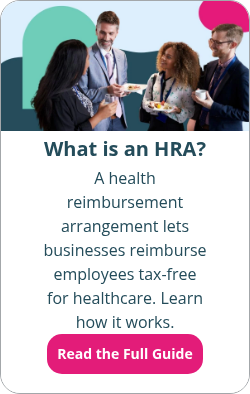How to write a job description that stands out
By Holly Bengfort on August 27, 2024 at 10:36 AM
When it comes to attracting top talent, a well-crafted job description can make all the difference. A generic job posting may not generate the interest you need from ideal candidates, so it's important to create a job description that stands out and grabs the attention of potential applicants.
In this article, we'll provide tips and strategies to help you craft an engaging job description that's unique and appealing to job seekers.
In this blog post, you'll learn the following:
- What key details lead to top-performing job descriptions.
- Which states require salary ranges in job listings.
- How employee benefits, such as health insurance, are essential in standing out to job seekers in a competitive job market.
What should you put in a job description?
An effective job description template summarizes the role, your organization, what makes an employee successful in the role, and your organization's vision and values. It's also your time to convince job applicants why they should work for you.
Your detailed job description should include:
- The job title for the position you're looking to fill
- Job summary with an overview of the role
- A summary of what your organization does and why it matters
- Job responsibilities and duties
- Qualifications and skills required or desired
- Salary or salary ranges
- The benefits you provide
Balancing financial and non-financial incentives is key to a compelling job description. LinkedIn's Global Workplace Study1 found that employees value salary and benefits most when looking for a new role.
Job titles
Be sure to use specific job titles that job seekers will understand. After all, many applicants search for new positions by job titles online.
You should also specify whether it is an entry-level position or a senior-level position, which would require more professional experience. For example, if you're hiring a copywriter with a minimum of 10 years of experience required, you could title your job listing as “Senior copywriter.”
Job summary
Your job summary should accurately reflect the role, including a typical day for the job applicant. Your job summary should also include the location of the position (including if it's remote or hybrid) and the expected hours and workdays.
Your organization's summary
Candidates want to work for a company that aligns with their values and beliefs. Use the job description as an opportunity to showcase your company culture, values, and anything else that helps tell your brand's story. Explain what makes your company unique and why someone would want to work for you.
Francisco Romero owns Romero Hardwood Floors2. He recognizes the significance of these key details in creating top-performing job descriptions.
"For example, we highlight our commitment to sustainability and work-life balance," Romero said. "We find that emphasizing these aspects attracts candidates who are passionate and driven."
Job responsibilities and duties
This is where you can list the key responsibilities and tasks your ideal employee will perform. Try to be specific, but make it a concise description. You don't need to list every day-to-day responsibility. You can also share who the applicant will report to and how their role matters to the organization.
While you want to entice job seekers, Romero said it's important to not over-sell or misrepresent the role in your description.
"Provide a balanced and realistic preview of what the job entails, focusing on the opportunities for impact and growth," Romero said. "This transparency builds trust and helps find better long-term fits."
Key skills and qualifications
It's good to list a few preferred qualifications or relevant skills that will help an employee excel in their new role. This helps job-seekers identify if they match the position.
One mistake that recruiters make is listing every qualification under the sun. Rather than limiting the pool of potential candidates, this actually expands the number of applicants. If a candidate has relevant experience in one of the listed areas, they take their chance. So, if you want to avoid sifting through dozens of job applications from unqualified candidates, only list the essential qualifications.
Be sure to include a mix of hard skills and soft skills.
Hard skills are job-related abilities, such as:
- Mathematical skills (like Calculus or discrete mathematics)
- Technical skills, such as software proficiency
- Search engine optimization
- Computer programming
- Copywriting experience
- Foreign languages
Soft skills are critical habits and traits candidates may have, such as:
- Interpersonal skills
- Excellent communication
- Teamwork
- Creativity
- Organizational skills
- Critical thinking
- Open-mindedness
- Kindness
The most qualified candidates have a mix of both hard and soft skills, so be sure to list the most important of each set.
Try to be as specific as possible when listing your essential skills. For example, share what that looks like instead of listing “good organizational skills” or “communication skills” for a role. Is clear and concise writing necessary due to the high volume of emails they'll writing? Or is public speaking experience required for your ideal hire?
You might also separate the “must-haves” from the “wants” so that prospective candidates know which key skills are required for the position and which ones will help set them apart from the rest.
Salary and benefits
Simply using your job ad to focus on what you're looking for is only half of the equation. Your post needs to show what you're doing for employees. That's why posting your salary ranges and employee benefits is critical.
In fact, some places even require that you list salary ranges in job postings before you ever interview an eligible candidate for the role.
These places include3:
- California
- Colorado
- Hawaii
- Illinois (effective January 2025)
- New York City
- Washington
Listing all of your employee benefits is a great way to create an engaging job description. The more attractive you can make your compensation package, the better you can attract top talent, even in a tight labor market.
Some of the top employee benefits are:
- Health insurance
- Paid time off (PTO)
- Dental insurance
- Vision insurance
- Retirement benefits
- Education benefits
- Remote or hybrid work
- Wellness programs
When multiple companies offer comparable pay, it's the benefits that make the difference. Romero uses this to his advantage in his job postings.
"To set ourselves apart, we highlight our training programs and opportunities for career growth. We invest heavily in our employees and want candidates to know that," Romero said. "We cover the costs for employees to earn additional certifications and pursue continuing education."
This career growth is something many job seekers crave. The 2024 Employ Job Seeker Nation Report4 found that 52% of employees said they're looking for career advancement in their job search.
How to bolster your benefits package on a budget
According to our 2024 Employee Benefits Survey, 81% of employees said an employer’s benefits package is an important factor in whether or not they accept a job. But, some benefits are better than others at attracting eligible candidates. Year after year, health benefits rank as the most desired employee benefit. Our survey found that 92% of employees rated health benefits as important.
But health benefits are often to expensive for many employers to offer. However, that's only the case if you're looking at traditional group health insurance plans. The rising costs of these plans have led some employers to offer more cost-effective alternatives, such as health reimbursement arrangements (HRAs) and health stipends.
Health reimbursement arrangements
HRAs are a tax-advantaged alternative to group health insurance that gives your employees more control over their health benefits costs. With an HRA, employers reimburse employees for their qualifying medical expenses.
Three of the most popular types of HRAs are:
- Qualified small employer HRA (QSEHRA)
- Individual coverage HRA (ICHRA)
- Group coverage HRA (GCHRA), also known as an integrated HRA
Health stipends
You can also offer a health stipend to your employees. This works similarly to an HRA, but it allows for greater flexibility because you reimburse any medical expense at your discretion. However, health stipends are taxable.
While an HRA is often a better choice for organizations, health stipends can be helpful if you have 1099 contractors, international workers, or employees who receive advance premium tax credits (APTC).
Conclusion
A well-written job description requires a blend of creativity, clarity, and strategic thinking. It's not just about listing responsibilities and qualifications. It's about painting a vivid picture of what it's like to work at your company and why someone should be eager to apply for the role.
A competitive employee benefits package always piques the interest of potential candidates. If you're interested in offering affordable health benefits to your employees, PeopleKeep can help! Our HRA administration software solutions make it easy to manage your benefits in minutes each month.
This blog article was originally published on May 25, 2015. It was last updated on August 27, 2024.
Check out more resources
See these related articles

What is employer-sponsored health insurance?
Learn what employer-sponsored health insurance is in this beginner's guide. Discover how it works and the benefits it offers to employees and businesses.

What are portable benefits?
Portable benefits are benefits employees can take with them from job to job. See how they offer flexibility and long-term security across careers.

What is a burden rate?
The burden rate is the total indirect costs associated with employing a worker, such as benefits, taxes, and overhead. Learn more about burden rates here!



